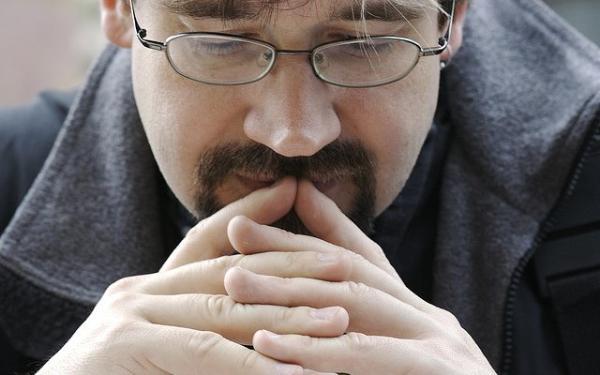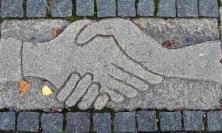‘Who is God for me?’ Helen Costigane suggests that asking this question of ourselves, and listening closely to the answer, might be the best way for our consciences to be formed and informed. How does our image of God relate to our moral development?
In the town square of a mountain village in Iran in 1986, a young married woman, named Soraya, faces the men and women she has lived amongst. She is the wife of a bullying, womanising villager named Ali who wants out of their marriage so that he can wed a younger, 14-year-old girl. A powerful man with deep connections to the revolutionary government and plenty of dirt on most of his colleagues, Ali becomes frustrated with Soraya’s decision not to grant him a divorce, because it will mean she and her two daughters will be left without enough income to survive. Ali and his friends suggest that Soraya does housework for the elderly widower Hashem in order to make some money of her own. However, Ali soon realises how easily certain rumours could be spread about a married woman who frequently visits a single man, and comes up with a much more sinister plan to rid himself of Soraya. He accuses her falsely of adultery; her case is heard by the all-male court and, being found guilty, her penalty is to be stoned to death. Buried up to her waist in the town square, the stones rain down on her, thrown by her father, husband, sons and neighbours. Various expressions are seen on the faces of the onlookers – anger, shock, horror, confusion, fear and satisfaction. Ali smiles as he realises that he has his freedom to marry again. The cry goes up from several of the men: ‘God is great!’[1]
While there are a few in the crowd who know that what they are doing is wrong, there are some who clearly believe that they are following their conscience and doing what they think that God is asking of them. Ibrahim, the mayor, is a case in point. Before the execution, he prays, trying to discern whether this is really what God demands. History is replete with stories of actions which we now find repugnant, such as the burning of witches and heretics, torture, self-immolation and murder. Many people, like Soraya’s persecutors, claim to be doing what God has asked them to do. How do we understand this idea of faith in relation to what we call ‘conscience’?
Definitions abound of what we understand by ‘conscience’. Over the years, my students of Christian Ethics have provided a number of these, among the most common being something ‘that tells us right from wrong’ or ‘makes me feel guilty’, or ‘a voice that directs or guides’. A more memorable one is: ‘something nagging in the background – like another mother’! Theologians such as Kenneth Overberg tell us that making moral decisions requires ‘a mature decision maker’, in which conscience has a central role.[2] Conscience is variously described by moral theologians as ‘an experience of mind and heart, the innate thrust of our human nature to love the good and avoid evil’[3]; ‘personal moral awareness’[4]; and ‘an inner sense of what is right or wrong in the person’s intentions and activity’.[5] Anne Patrick makes the point that conscience is not something ‘out there’, giving us commands. It is something that is part of us, an awareness of the persons we are becoming that arises through reflection on past, present and future. It is described by one writer as ‘internalised speech – the inner voice [which] plays a crucial role in regulating behaviour’.[6] At first sight, there seems to be little connection between these ideas, but a helpful model for examining links between them is Richard Gula’s identification of three aspects of the idea of conscience.[7] These he names as ‘capacity’, ‘process’ and ‘judgement’.
Gula notes that all human persons (except for aberrations such as sociopaths) are born with a capacity to know and do the good. As such, this first aspect of conscience empowers or enables us to search out the ‘truth’. Though this facet of conscience cannot be lost, it may be impaired by habitually doing evil. In other words, the capacity to know the good may be weakened but not lost altogether. However, this capacity, a part of our human nature, needs to be formed and shaped. This process of formation is the second identifiable aspect of conscience. In forming and informing itself, conscience listens to and dialogues with different sources of moral wisdom. Richard C. Sparks[8] names the sources and processes that a person may call on to make a moral decision as: scripture, one’s religious community, the sciences, reasoning and prayer. It is at this level that there may be disagreement on issues, in terms of conflicts of interpretation and received wisdom. However, in the real world, we cannot be perennial observers and, at some stage, we are required to act on the knowledge and wisdom we have. Conscience, then, involves a judgement in a particular situation. It is at this stage that personal responsibility and accountability become important; this is my decision, based on the best knowledge and information I have at the time.
So, we are born with the capacity to know right from wrong, though we need to be able to discover ‘right’ and ‘wrong’ in practical situations. We learn this from our parents, teachers and all who influence us during our lives. This, then, informs the way we act in particular circumstances. This relational aspect of morality helps us see that morally good or bad actions are those that either foster or damage relationships and personal growth. However, this is not the end of the story, for we need to reflect on the decisions we have taken, and perhaps re-evaluate the more crucial ones in the light of new knowledge gained, increased sensitivity or wider experience. In this sense, it is clear that – if conscience is developing as we mature and grow throughout our lives – the decisions we make (and, indeed the kinds of decisions we make) at the ages of 10, 20, and 40 will be very different.
In the development of conscience, we might ask why it is that the capacity to know good from evil might be impaired, or how the process of formation and information-gathering might be stunted. In a practical situation, how might a judgement be flawed or acted against? There are many issues that could be considered, including how emotions such as anger, fear and prejudice might cloud judgement, or how we might simply ‘go with the flow’ and do what the crowd is doing, for the sake of peace, or to avoid the crowd turning on us. Another question we might explore, returning to the story of Soraya, is that of why such a violent act occurred with people acting ‘in the name of God’.
We might approach this question by considering how we ‘image’ God and how we think about what God is asking of us. One way of looking at this is considering how we develop as moral beings. We are not born with the ability to make mature, reasoned decisions of conscience immediately, rather we learn about the world through a process of growth and development. A number of people have formulated theories about stages or patterns of moral development, including figures such as Erik Erikson, Lawrence Kohlberg, Carol Gilligan and Jane Loevinger. All of them have something to contribute to our understanding of how conscience develops, though no single theorist gives us the whole picture. One major theory (though not without its critics) is that of Lawrence Kohlberg, who identifies six stages of cognitive development by considering a particular scenario in which he explores what people think they ought to do when faced with a moral decision.
At what Kohlberg calls the ‘pre-conventional’ level are two stages of ‘punishment’ and ‘reward’. Most mothers will recognise the scenario of their two-year-old child throwing a tantrum at the supermarket and demanding sweets. What do you do to modify their behaviour? Years ago, a well-placed slap was deemed acceptable; today, parents may well resort to rewarding children if they give up the tantrum, or if they agree to behave well in the first place. This idea of behaving according to ‘reward’ or ‘punishment’ is not restricted solely to children; adults may also adopt similar motivations for behaving in certain ways. God, at this level, may be envisaged as a stern father who punishes or rewards, and conscience-thinking would involve moral thinking that was either authority-oriented or individualistic and instrumental. In terms of Soraya’s story, there was a clear deference to authority: the fact that she was convicted by a council of elders and ratified by the imam was enough to convince the crowds that the stoning was in accordance with the law of God.
The hallmarks of the next level - the ‘conventional’ - may be summarised as ‘approval’, ‘duty’ and ‘conformity’. This level has manifold implications for the development of conscience. There are a number of rules and regulations of a society on which we can agree. The need to obey certain laws for the sake of the common good is evident to most people; hence most people respect the proscription of actions such as putting graffiti on walls, driving through red traffic lights, cruelty to animals, driving while under the influence of alcohol, attacking innocent people and downloading child pornography. Through a process of socialisation, a child learns how things are done and ‘create[s] a system of beliefs, attitudes, and personal standards that determine how we interact with the world around us’.[9]
This raises questions, though, about the nature of socialisation. Ladislas Orsy’s idea of ‘horizon studies’ is a useful model to explore this. Orsy says that when we look at the sky at night with the naked eye we may see some stars, though possibly with some difficulty because of light pollution. Viewing the starry sky from the desert or through a telescope allows us to see much more clearly; in essence, our physical horizons have expanded. Similarly, experiencing different lands and cultures, and seeing for ourselves different models of living and ways of believing, expands our own horizons and gives us something against which we may compare our own experiences. However, it is not just physical horizons that alter but mental ones too. Understanding how stars come into being, how they move in relation to the earth and how they cease to exist, gives us more insight into how the universe operates. In the same way, our horizons can alter in ways of thinking about people, families, societies and cultures as we grow in knowledge of areas such as psychology, sociology and anthropology. However, just as horizons may expand, they can also shrink, or remain narrow.
A ‘consensus of conscience’ regarding the society in which we live may not necessarily be a bad thing. We all need some rules we can agree on, and there are certain issues on which we can and do take a common stance. For example, it is generally accepted that we should not tolerate acts such as genocide, murder and rape. In terms of forming conscience, then, there are certain standards that most right-minded people can agree on. Having a consensus on societal norms can be positive, and enables people and communities to live in relative harmony. At the same time, there is a danger in ‘consensus’, in that it can lead to individuals following the crowd, often with tragic consequences.
As with the other levels in Kohlberg’s model, there are two stages here. At the first stage, right behaviour is what pleases, helps others and gains their approval. At the second stage this is defined in terms of doing one’s duty, specified by rules of society. God here is seen as the Lawgiver, and obedience is required to community laws and traditions. Part of the problem for conscience is in the interpretation of those laws which may be set out in sacred scriptures. Deciding what constitutes the ‘letter’ and the ‘spirit’ of the law is what is at issue here. Soraya’s story illustrates the problem of narrowly interpreting what God requires of a community and of ‘imaging’ God solely in terms of law rather than relationship.
In Kohlberg’s scheme, at the‘post-conventional’ level the individual desires the greatest good for the greatest number or, in the second stage, the autonomous, rational individual acts according to certain principles. We might identify Jesus (as Kohlberg did) as the model for such an individual. Other examples might include highly principled individuals such as Mahatma Gandhi, Dorothy Day or Franz Jägerstätter, as well as the many saints recognised by the Church for their lives of heroic dedication and witness. At this level, individual conscience is paramount, although it is not formed in isolation. God is seen as a Lover or Companion, with the imperative given to all to love God, neighbour and self.
We do not have to have faith in order for conscience to work well. It is possible to learn how to live well by learning from good role models, from reflecting on experience and by striving to know ourselves. For Christians, though, faith in God brings another important dimension. How we image God may well have an impact on how we interpret what we learn and experience, and this can have an impact in making important decisions of conscience. If Soraya’s community had had an image of God that was based on love rather than law, would the first stone have been thrown? Perhaps then the most important question Christians must ask themselves (and listen attentively to the answer) is: who is God for me?
Dr Helen Costigane SHCJ teaches Canon Law and Christian Ethics at Heythrop College, University of London.
[1] This true story was made into a film: The Stoning of Soraya M (Mpower Pictures, 2008).
[2] Kenneth R. Overberg, Conscience in Conflict: How to Make Moral Choices (Cincinnati: St Anthony Messenger Press, 1998), p. 43.
[3] Sean Fagan, Does Morality Change? (Dublin, Gill and Macmillan, 1997), p. 107.
[4] Anne E. Patrick, Liberating Conscience: Feminist Explorations in Catholic Moral Theology (London: SCM, 1996), p. 35.
[5] Linda Hogan, Confronting the Truth: Conscience in the Catholic Tradition (New York: Paulist Press, 2000), pp. 9-10.
[6] Robert D. Hare, Without Conscience: The Disturbing World of the Psychopaths Among Us (London: Guilford Press, 1999), p. 77.
[7] Richard Gula, Reason Informed by Faith (New York: Paulist Press, 1989), pp. 131-135.
[8] Contemporary Christian Morality: Real Questions Candid Responses, (New York, Crossroad, 1996) pages
[9] Hare, p. 75.






